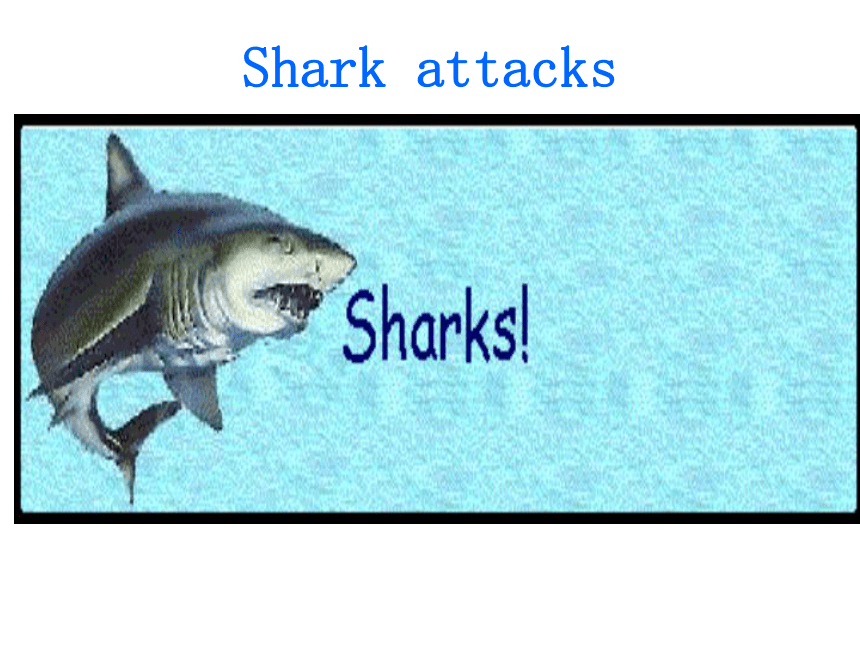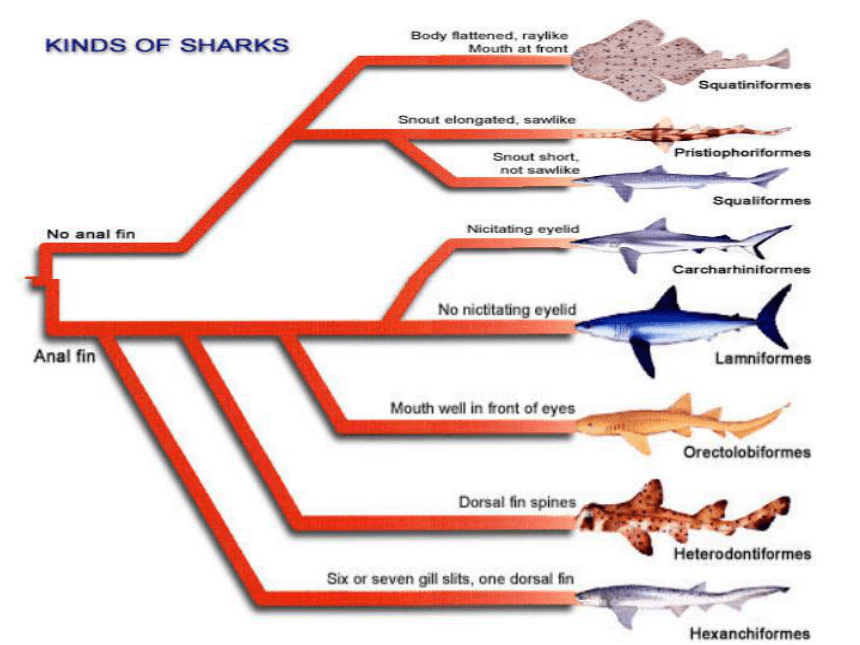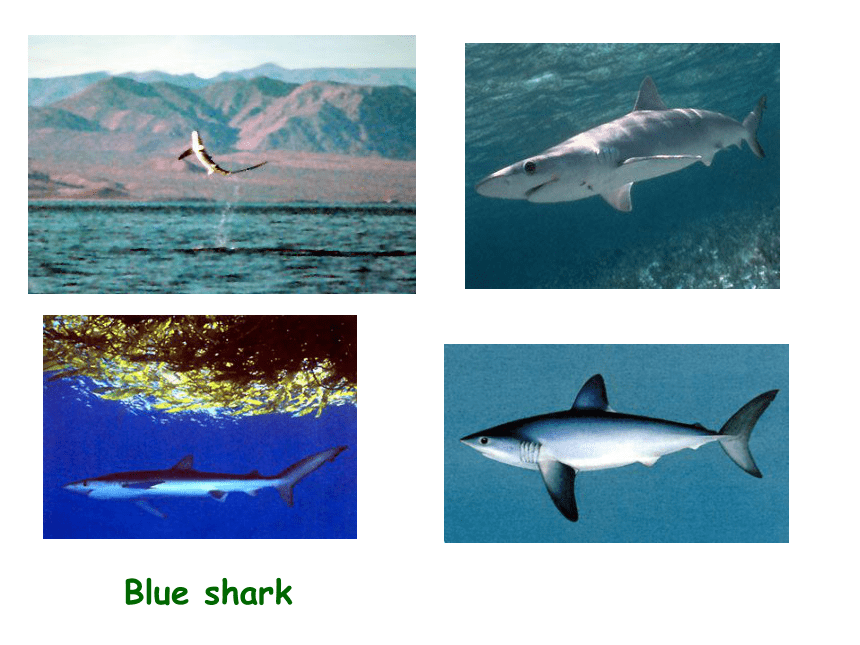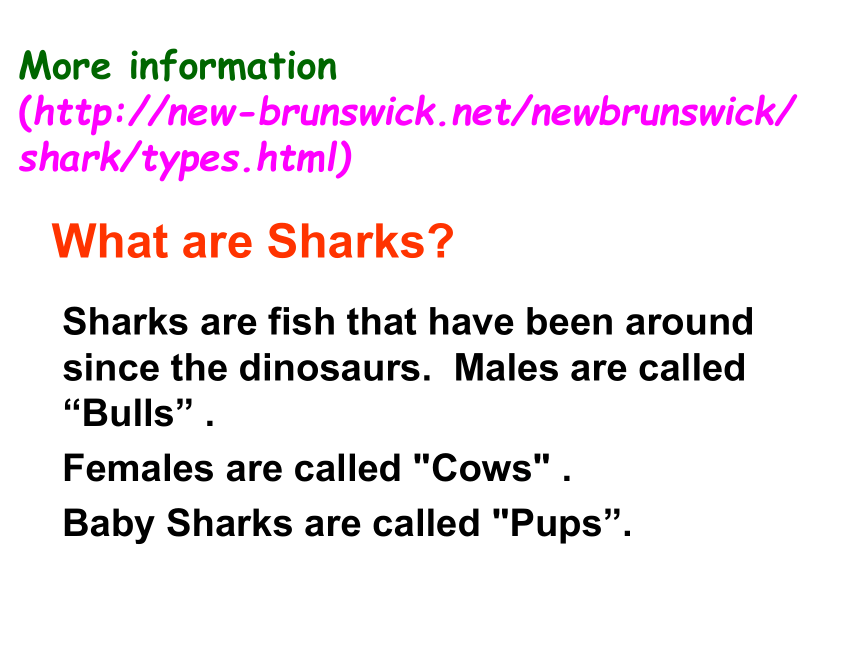Unit1 The world of our senses课件
文档属性
| 名称 | Unit1 The world of our senses课件 |  | |
| 格式 | zip | ||
| 文件大小 | 8.0MB | ||
| 资源类型 | 教案 | ||
| 版本资源 | 牛津译林版 | ||
| 科目 | 英语 | ||
| 更新时间 | 2013-10-22 17:24:11 | ||
图片预览









文档简介
课件26张PPT。The world of our sensesUnit 1Project Producing
a TV showShark attacksWhale sharkBasking sharkGreat whiteTiger sharkBlue sharkMore information
(http://new-brunswick.net/newbrunswick/
shark/types.html)What are Sharks? Sharks are fish that have been around since the dinosaurs. Males are called “Bulls” .
Females are called "Cows" .
Baby Sharks are called "Pups”.Other shark facts Sharks have five to seven gill slits. Many sharks must keep moving in order to breathe that is, in order to keep water moving past their gill slits but this is not true of all species. Nurse sharks, for example, can lie still and fan their gills to bring oxygen-rich water across the slits. Because they lack a swim bladder, all sharks must swim in order to avoid sinking toward the ocean floor. The shark has senses specially adapted for the animal's life underwater. Smell is a shark's most acute sense. Approximately 70 percent of the shark's brain is used for olfactory (smelling)? functions. Experiments have shown that sharks can detect prey solely by smell, and the hungrier the shark, the less stimulant needed to elicit a reaction. Sharks are sensitive to light and can detect certain objects even in murky water. Some have a tapetum lucidum, a mirror like layer under the retina of the eye that reflects incoming light and increases the amount of light available to the eye. (Cats and other animals whose eyes "glow in the dark" also have this feature.) Sharks do have ears, but the role of hearing in the shark's location of prey is not well understood. A shark can detect sound waves and disturbances in the water with its lateral line, or lateralis, system. This is a series of thin canals, filled with water, that runs along the animal's side. The canals are attached to nerves that send signals to the shark's brain. Sharks can also sense electric and magnetic fields. Sensory pores located on the shark's head can detect a prey's bioelectric field even if the prey is buried in sand. A shark can also detect the Earth's magnetic field. Open-ocean sharks may use this information to navigate and orient themselves.?Fast reading :1. What do you know about sharks?
2. How many different types of sharks are there in the ocean?
3. Do all of them attack humans?
4. How to avoid being attacked by sharks?
5. What are their unique senses?Careful reading: Read the text again and try to find out the main idea of each paragraph.
Paragraph 1: There are nearly 400 types of
sharks.
Paragraph 2: Sharks do not feed on humans.
Paragraph 3: There are three types of shark
attacks.
Paragraph 4: An increase in water sports has
led to an increase in shark
attacks.
Paragraph 5: There are three tips on what to
do if a shark attacks.
Paragraph 6: Do not be frightened by sharks.Language focusI’m sure you are clever enough to work them out!He has much _______ of winning the first prize.
2. The chances are a hundred to one against you,
it’s most ______ that you will succeed.
3. What does the little dog chiefly _____ _____?
4. Don’t hit him ____ ____ head!
5. Why not wear some flowers instead of _____
when you go to the ball?
chanceunlikelyfeed onon thejewelleryUseful phrases mainly because
two other sharks
the chances of being
attacked
4. compared to
5. many more people
6.the low number
7.feed on
8. be fit to do
9.wait for sb to do
10.the latter two 11.follow the advice
12.have a fresh wound
13.be more likely to be deadly
14.over a long distance
15.wear bright clothing
or jewellery
16.hit the shark on the nose
17.stick your finger in the
shark’s eye
18.30 times greater
BProduce a TV show about how an animal uses its senses.Planning Get into groups(6-8).
Decide which animal to focus on.
Clear assignments.
The animal’s nameIt’s unique senseDecide what type of show :
A documentary, a drama, a cartoon, other showClear assignmentsEach member picks a different topic to find information about
Food( what the animal eats)
Habitat(where the animal lives)
Size(size of the animal or population)
Myths about this animal(what people think)Preparing Visit a zoo , watch an animal documentary, look at books, surf the Internet……to find information about the animal.
What it eats and how it finds food in the wild
How it protects itself
How it communicates with other animals
How it attacks people or other animals (if it does)
How it helps people or other animals (if it does)
Producing
1. Focus your research on how your animal uses its senses.
2. TV is very visual so pictures should be
presented in an easy to see way.
3. Each member must work on different part of the show, keeping in mind the overall design.
4. Each member has to proofread the writing at least once, correct mistakes if there are any,
and add any new ideas they can think of.PresentingPresent your show to the class.
Put you display on the display wall.HomeworkDo Parts A, B and C on page 90 in Workbook.
Review words and phrases in this unit.
a TV showShark attacksWhale sharkBasking sharkGreat whiteTiger sharkBlue sharkMore information
(http://new-brunswick.net/newbrunswick/
shark/types.html)What are Sharks? Sharks are fish that have been around since the dinosaurs. Males are called “Bulls” .
Females are called "Cows" .
Baby Sharks are called "Pups”.Other shark facts Sharks have five to seven gill slits. Many sharks must keep moving in order to breathe that is, in order to keep water moving past their gill slits but this is not true of all species. Nurse sharks, for example, can lie still and fan their gills to bring oxygen-rich water across the slits. Because they lack a swim bladder, all sharks must swim in order to avoid sinking toward the ocean floor. The shark has senses specially adapted for the animal's life underwater. Smell is a shark's most acute sense. Approximately 70 percent of the shark's brain is used for olfactory (smelling)? functions. Experiments have shown that sharks can detect prey solely by smell, and the hungrier the shark, the less stimulant needed to elicit a reaction. Sharks are sensitive to light and can detect certain objects even in murky water. Some have a tapetum lucidum, a mirror like layer under the retina of the eye that reflects incoming light and increases the amount of light available to the eye. (Cats and other animals whose eyes "glow in the dark" also have this feature.) Sharks do have ears, but the role of hearing in the shark's location of prey is not well understood. A shark can detect sound waves and disturbances in the water with its lateral line, or lateralis, system. This is a series of thin canals, filled with water, that runs along the animal's side. The canals are attached to nerves that send signals to the shark's brain. Sharks can also sense electric and magnetic fields. Sensory pores located on the shark's head can detect a prey's bioelectric field even if the prey is buried in sand. A shark can also detect the Earth's magnetic field. Open-ocean sharks may use this information to navigate and orient themselves.?Fast reading :1. What do you know about sharks?
2. How many different types of sharks are there in the ocean?
3. Do all of them attack humans?
4. How to avoid being attacked by sharks?
5. What are their unique senses?Careful reading: Read the text again and try to find out the main idea of each paragraph.
Paragraph 1: There are nearly 400 types of
sharks.
Paragraph 2: Sharks do not feed on humans.
Paragraph 3: There are three types of shark
attacks.
Paragraph 4: An increase in water sports has
led to an increase in shark
attacks.
Paragraph 5: There are three tips on what to
do if a shark attacks.
Paragraph 6: Do not be frightened by sharks.Language focusI’m sure you are clever enough to work them out!He has much _______ of winning the first prize.
2. The chances are a hundred to one against you,
it’s most ______ that you will succeed.
3. What does the little dog chiefly _____ _____?
4. Don’t hit him ____ ____ head!
5. Why not wear some flowers instead of _____
when you go to the ball?
chanceunlikelyfeed onon thejewelleryUseful phrases mainly because
two other sharks
the chances of being
attacked
4. compared to
5. many more people
6.the low number
7.feed on
8. be fit to do
9.wait for sb to do
10.the latter two 11.follow the advice
12.have a fresh wound
13.be more likely to be deadly
14.over a long distance
15.wear bright clothing
or jewellery
16.hit the shark on the nose
17.stick your finger in the
shark’s eye
18.30 times greater
BProduce a TV show about how an animal uses its senses.Planning Get into groups(6-8).
Decide which animal to focus on.
Clear assignments.
The animal’s nameIt’s unique senseDecide what type of show :
A documentary, a drama, a cartoon, other showClear assignmentsEach member picks a different topic to find information about
Food( what the animal eats)
Habitat(where the animal lives)
Size(size of the animal or population)
Myths about this animal(what people think)Preparing Visit a zoo , watch an animal documentary, look at books, surf the Internet……to find information about the animal.
What it eats and how it finds food in the wild
How it protects itself
How it communicates with other animals
How it attacks people or other animals (if it does)
How it helps people or other animals (if it does)
Producing
1. Focus your research on how your animal uses its senses.
2. TV is very visual so pictures should be
presented in an easy to see way.
3. Each member must work on different part of the show, keeping in mind the overall design.
4. Each member has to proofread the writing at least once, correct mistakes if there are any,
and add any new ideas they can think of.PresentingPresent your show to the class.
Put you display on the display wall.HomeworkDo Parts A, B and C on page 90 in Workbook.
Review words and phrases in this unit.
